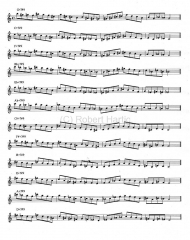The diminished whole tone scale (aka super locrian or Pomeroy scale) has been around for a long time, but it’s still a foreign sound to ears that are steeped in basic major and minor scales. For as many years as I’ve been playing it, it’s still not something I find myself idly humming. Nevertheless, it’s an extremely useful scale, full of colors and possibilities for chord superimpositions.
Think of the diminished whole tone scale as a mode built upon the seventh degree of the ascending melodic minor scale. For instance, a C melodic minor scale contains these notes: C, D, Eb, F, G, A, B, C. Start on B as the scale root rather than C and you’ve got a B diminished whole tone scale.
The scale’s primary use is with the altered dominant seventh chord, which it fits like a glove. The diminished whole tone scale contains virtually every common alteration of the dominant chord you can conceive of: b9, #9, +5, and +11. So when you see, for instance, an A+7#9, the A diminished whole tone is a scale option that should come instantly to mind. Like any scale, you can conceive of it as simply a linear repository of tones, all of which relate perfectly to the altered dominant chord.
The exercise on this page explores three of the many harmonic possibilities contained within the diminished whole tone scale. Click on the image to enlarge it. Each four-bar line sets a given scale against its respective altered dominant chord.
.
The purpose of this exercise isn’t so much to give you a great lick as to help you dig inside the diminished whole tone scale to see what it has to offer. There’s plenty more to discover, so consider this a springboard to further exploration. You’d do well to use some kind of harmonic accompaniment as you play this exercise, so you’re training not just your fingers but also your ears.
Practice hard and have fun! And be sure to visit my jazz page for a large selection of other informative articles, exercises, and solo transcriptions that can help you develop as a jazz improviser. They’re all free, so dig in, learn, and grow with me musically.



